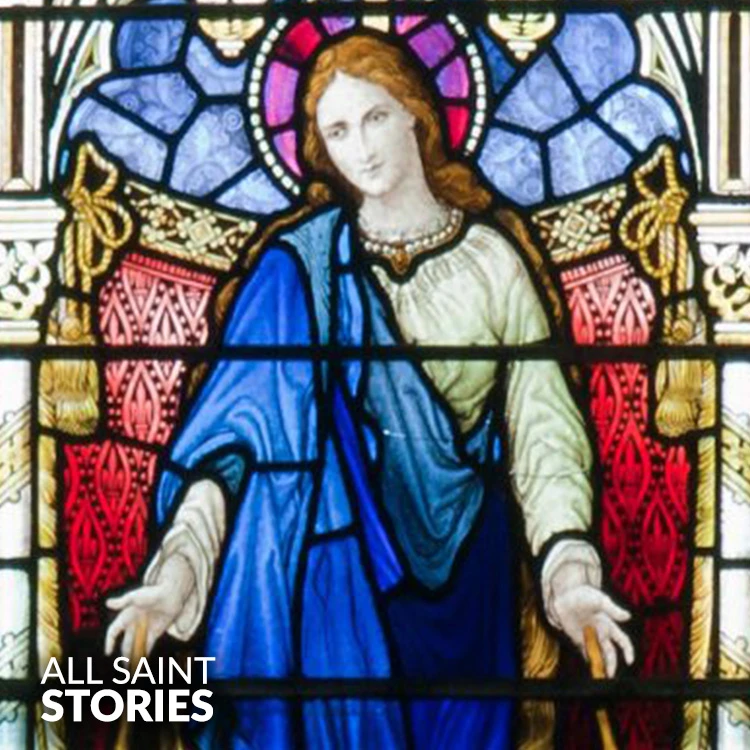Heavenly Father, we humbly ask for the intercession of St. Stella, whose devotion reflects unwavering faith. May her example of purity and generosity guide us in times of need, inspiring trust in your divine mercy and love. Illuminate our hearts so we may serve you with steadfast conviction, and bless our daily actions with your grace. Through her prayers, bring us closer to your presence and strengthen our desire to uplift those around us with kindness. Amen.
ST. STELLA
ST. STELLA

St. Stella is a locally honored figure, traditionally revered for her deep compassion and humble service. Though her historical origins are unclear, popular stories describe her as a devout Christian woman of the early Church, remembered for tending to the sick and providing refuge to travelers. She is sometimes invoked for guidance and hope in uncertain times. Her supposed feast day on September 1 has long been associated with earnest prayers for healing and unity. While not officially recognized in mainstream hagiographies, St. Stella’s devotion exemplifies virtues of humility, hospitality, and unwavering faith in God’s providence.
| St. Stella is enveloped in local legends that speak of her gentle spirit and quiet resolve. The accounts that survive are chiefly oral traditions passed down in certain small Christian communities. These stories place her in a remote coastal region during a period of significant social and religious transformation, possibly around the fourth or fifth century. At this time, Christianity was still finding firm footing in areas far from major urban centers. Few written records existed to document the everyday lives of those who practiced their faith in small hamlets or along trade routes, and so the figure of St. Stella appears primarily as a figure shaped by collective memory rather than historical archives. Over time, devout individuals maintained shrines dedicated to her, inscribing her name on modest plaques or within personal prayer books, ensuring that she was not entirely forgotten by the passing centuries. |
Stories portray St. Stella as an orphan whose faith in Christ was nurtured by the steadfast guidance of a local community elder. Some accounts say she was baptized in a clandestine ceremony to avoid detection by those who resented the spread of Christian beliefs. Growing up in an environment colored by fear and uncertainty, she found consolation in teachings of charity and compassion. As she reached adolescence, her fervent love for God became evident in her tireless dedication to helping neighbors who struggled with hunger or illness. In an age lacking the medical knowledge of modern times, even small acts of caregiving could mean the difference between life and death. Oral traditions describe her walking along rugged paths to deliver food, herbs, and prayers to anyone in distress. Word of her kindness spread through distant regions, with travelers reporting that this pious young woman always received them with open arms and offered whatever limited resources she had.
Around the region, it was whispered that miraculous occurrences trailed in her footsteps. An old ballad recounts how a community ravaged by drought saw relief after St. Stella organized days of public prayer and fasting. While rational explanation might attribute the end of the drought to changing weather patterns, her contemporaries believed these events illuminated the power of faith. In her small coastal settlement, she arranged communal gatherings that combined practical help with spiritual encouragement, reminding those who came to her that even when life’s circumstances were bleak, hope could be renewed through trust in God’s mercy. This trust was not superficial optimism; it was anchored in the conviction that divine aid would manifest, especially when people united in mutual support. Over time, these gatherings took on a formal character, resulting in a small local fraternity dedicated to living out charity according to her teachings. St. Stella continued offering physical and spiritual shelter, refusing to turn away anyone seeking assistance. As a result, her modest abode often overflowed with people of varying backgrounds—farm laborers, fisherfolk, wanderers, and even occasional Roman officials caught in unexpected storms. Each new arrival found a corner to rest and a table at which to share a meal, however simple.
Despite such virtuous work, times of peril and upheaval inevitably arose. Occasionally, the accounts describe hostility from influential figures who viewed Christianity as a threat to established traditions or local superstitions. A few stories recount that she faced verbal threats, was accused of stirring unrest by drawing the disenfranchised together, and even had her property damaged. Yet, the same sources emphasize that her willingness to forgive and her quiet fortitude often diffused tensions. She neither retaliated with anger nor flinched from danger. Instead, she persisted in prayer, trusting that her service to the needy spoke more powerfully than words of condemnation. In many narratives, her calm presence and unyielding kindness eventually persuaded even the most suspicious onlookers to reevaluate their stance. Whether these accounts are factually precise or elaborations meant to inspire devotion, they illustrate an image of sanctity that resonates with timeless Christian virtues.
Late in life, she is said to have carried on her mission with diminishing physical strength but unwavering resolve. She might have suffered periods of illness or malnourishment, for she regularly gave away most of her resources. Observers noted that she was thin but had a radiant countenance, as if inward joy sustained her when material comforts were scarce. Visitors to her home marveled at how tidy it was, considering the constant flow of impoverished souls who found refuge under her roof. There are mentions of a small oratory set aside for continuous prayer. By candlelight, St. Stella would pray aloud during the nights, invoking divine blessings for the travelers who were about to set forth at dawn. Others speak of a daily routine in which she woke long before sunrise to gather water and bake bread, ensuring that nobody left her home without nourishment. Over months and years, she gathered a small circle of companions who assisted her, effectively forming a proto-convent that specialized in hospitality rather than isolation from the world. In many retellings, this group grew into a supportive micro-community that adopted rules resembling those found in later monastic orders, focusing on simplicity, prayer, and service.
As her final days approached, local lore suggests she experienced visions or spiritual ecstasies. In one account, townspeople claimed they could hear her singing hymns in the silent hours of the night. Another account mentions her speaking in a voice that seemed amplified by grace, as though the lines between this world and the next were blurred around her. Her passing was reportedly peaceful and occurred in the presence of her companions and several guests who happened to be staying the night. A hush fell over the house, and word of her death quickly spread throughout the countryside. Though they were accustomed to sorrow, the community felt an acute sense of collective loss, aware that someone who had embodied Christ’s message was no longer in their midst. Neighbors and travelers alike gathered for an impromptu vigil, which ultimately turned into a week-long commemoration. To honor her memory, they initially placed her remains in a simple grave near the foot of a small altar, around which prayers continued to be offered. Over the decades, the site grew into a local pilgrimage spot, where the faithful claimed they found consolation in times of personal crisis. Even if official Church records never formally canonized her, in practice her veneration resembled that of other saints recognized by local devotion.
Oral tradition holds that a small chapel was eventually built on or near her burial site. Visitors would leave tokens of gratitude or petitions, often accompanied by short written notes of prayer requests. Although these chapels and relics do not appear in mainstream registers, the belief in St. Stella’s intercession persisted through centuries of political change, natural disasters, and social upheaval. It was said that storms subsided when her name was invoked, or that farmers who prayed at her chapel saw their crops restored after bouts of blight. The skepticism that eventually emerged in more urbanized and learned circles did little to diminish the convictions of the rural faithful. Pilgrims still arrived on foot each year around her feast day, seeking blessings of health, fertility for their lands, or reconciliation within their families. Accounts of answered prayers circulated, adding to her legend as an intercessor with a special sensitivity for practical human struggles. Parish priests in nearby towns often tolerated or even encouraged these devotions, noting that they reinforced piety and Christian charity among the local populace.
As contact between distant Christian communities increased, travelers carried stories of St. Stella to other regions, though her veneration always remained more of a local phenomenon than a universal devotion. Modern researchers who stumble upon references to her are unsure whether “St. Stella” was a single historical figure or an amalgamation of multiple pious women whose traditions were combined over time. Nevertheless, the themes that run through her narratives—compassion, unwavering service, and prayerful trust—continue to resonate with those who hear her story. In modern times, a few chapels and icons bearing her name still stand, albeit rarely visited except by locals or the occasional curious historian. The region itself has changed vastly, with improved infrastructure, hospitals, and social services supplanting the urgent need for private, faith-driven hospitality. Yet, her legend quietly reminds believers that even a single individual, armed with little more than conviction and love, can profoundly touch the hearts of many and leave a lasting imprint on a culture’s collective memory.
Video Not Found
The information on this website is compiled from various trusted sources. While we aim for accuracy, some details may be incomplete or contain discrepancies.
If you notice any errors or have additional information about this saint, please use the form on the left to share your suggestions. Your input helps us improve and maintain reliable content for everyone.
All submissions are reviewed carefully, and your personal details will remain confidential. Thank you for contributing to the accuracy and value of this resource.
Credits & Acknowledgments
- Anudina Visudhar (Malayalam) – Life of Saints for Everyday
by Msgr. Thomas Moothedan, M.A., D.D. - Saint Companions for Each Day
by A. J. M. Mausolfe & J. K. Mausolfe - US Catholic (Faith in Real Life) – Informational articles
- Wikipedia – General reference content and images
- Anastpaul.com – Saint images and reflections
- Pravachaka Sabdam (Malayalam) – Saint-related content and insights
We sincerely thank these authors and platforms for their valuable contributions. If we have unintentionally missed any attribution, please notify us, and we will make the correction promptly.
If you have any suggestion about ST. STELLA
Your suggestion will help improve the information about this saint. Your details will not be disclosed anywhere.
© 2025 Copyright @ www.allsaintstories.com




 English
English
 Italian
Italian
 French
French
 Spanish
Spanish
 Malayalam
Malayalam
 Russian
Russian
 Korean
Korean
 Sinhala
Sinhala
 Japanese
Japanese
 Arabic
Arabic
 Portuguese
Portuguese
 Bantu
Bantu
 Greek
Greek
 German
German
 Dutch
Dutch
 Filipino
Filipino